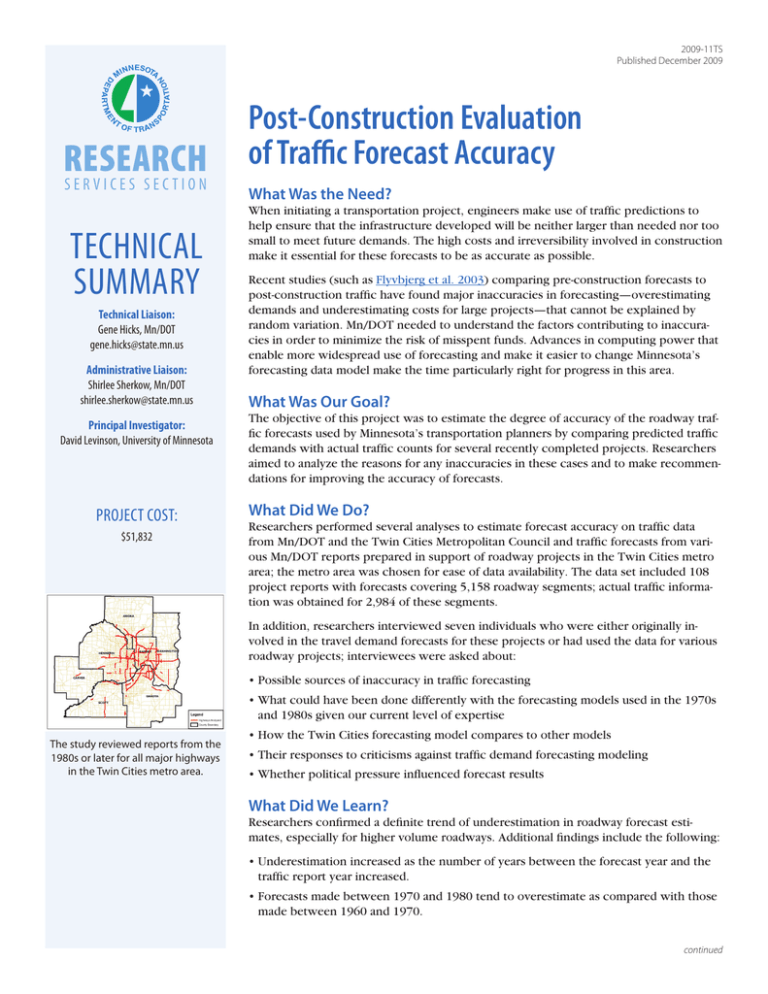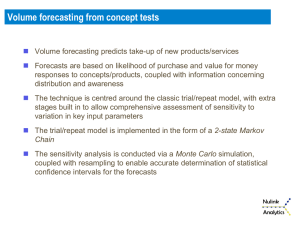RESEARCH Post-Construction Evaluation of Traffic Forecast Accuracy
advertisement

2009-11TS Published December 2009 RESEARCH SERVICES SECTION TECHNICAL SUMMARY Technical Liaison: Gene Hicks, Mn/DOT gene.hicks@state.mn.us Administrative Liaison: Shirlee Sherkow, Mn/DOT shirlee.sherkow@state.mn.us Principal Investigator: David Levinson, University of Minnesota PROJECT COST: $51,832 Post-Construction Evaluation of Traffic Forecast Accuracy What Was the Need? When initiating a transportation project, engineers make use of traffic predictions to help ensure that the infrastructure developed will be neither larger than needed nor too small to meet future demands. The high costs and irreversibility involved in construction make it essential for these forecasts to be as accurate as possible. Recent studies (such as Flyvbjerg et al. 2003) comparing pre-construction forecasts to post-construction traffic have found major inaccuracies in forecasting—overestimating demands and underestimating costs for large projects—that cannot be explained by random variation. Mn/DOT needed to understand the factors contributing to inaccuracies in order to minimize the risk of misspent funds. Advances in computing power that enable more widespread use of forecasting and make it easier to change Minnesota’s forecasting data model make the time particularly right for progress in this area. What Was Our Goal? The objective of this project was to estimate the degree of accuracy of the roadway traffic forecasts used by Minnesota’s transportation planners by comparing predicted traffic demands with actual traffic counts for several recently completed projects. Researchers aimed to analyze the reasons for any inaccuracies in these cases and to make recommendations for improving the accuracy of forecasts. What Did We Do? Researchers performed several analyses to estimate forecast accuracy on traffic data from Mn/DOT and the Twin Cities Metropolitan Council and traffic forecasts from various Mn/DOT reports prepared in support of roadway projects in the Twin Cities metro area; the metro area was chosen for ease of data availability. The data set included 108 project reports with forecasts covering 5,158 roadway segments; actual traffic information was obtained for 2,984 of these segments. In addition, researchers interviewed seven individuals who were either originally involved in the travel demand forecasts for these projects or had used the data for various roadway projects; interviewees were asked about: • Possible sources of inaccuracy in traffic forecasting • What could have been done differently with the forecasting models used in the 1970s and 1980s given our current level of expertise The study reviewed reports from the 1980s or later for all major highways in the Twin Cities metro area. • How the Twin Cities forecasting model compares to other models • Their responses to criticisms against traffic demand forecasting modeling • Whether political pressure influenced forecast results What Did We Learn? Researchers confirmed a definite trend of underestimation in roadway forecast estimates, especially for higher volume roadways. Additional findings include the following: • Underestimation increased as the number of years between the forecast year and the traffic report year increased. • Forecasts made between 1970 and 1980 tend to overestimate as compared with those made between 1960 and 1970. continued “It was very worthwhile for us to evaluate the historical accuracy of post-construction roadway traffic forecasts. This is an area where there really haven’t been very many studies done.” –Gene Hicks, Mn/DOT Principal Engineer This graph shows the ratio of forecasted traffic to actual traffic for projects in Dakota County. “This project included both quantitative analysis into the factors correlated with traffic forecast inaccuracy and qualitative analysis that helped identify the reasons for inaccuracy from a modeler’s perspective.” • Highways radiating from a common center were more prone to underestimation as compared with lateral highways. –David Levinson, What’s Next? Associate Professor, University of Minnesota Department of Civil Engineering Produced by CTC & Associates for: Minnesota Department of Transportation Research Services Section MS 330, First Floor 395 John Ireland Blvd. St. Paul, MN 55155-1899 (651) 366-3780 www.research.dot.state.mn.us • Forecasts for roadways running west from the Twin Cities showed a trend of underestimation, while those for roads running east were often overestimated. • Several factors were difficult or impossible to anticipate, including new attractions (for example, the Mall of America), societal changes (such as increases in women in the workforce, the number of autos per household and use of the Internet) and world events (such as rising gas prices and the current financial crisis). Interviewees for the most part agreed that political pressure was not a determining factor for inaccuracies in the Twin Cities projects; that the Twin Cities prediction model was as good, if not better, than those used by other cities; and that traffic demand predictions should not be based on the model’s results alone; rather the model’s data should be one tool used as part of the decision-making process. The project report recommends ongoing analysis of accuracy to continually refine modeling techniques, with better bookkeeping and archiving procedures to make it easier to conduct these types of analyses. In addition: • Modelers must better understand the impact of societal changes on traffic forecasts and incorporate these rather than solely relying on existing trends. • A greater emphasis on accurate demographics predictions will increase the likelihood of accuracy on traffic forecasts. • Nonmodeler decision makers in charge of funding must obtain at least a basic understanding of the science behind forecasts, including the limitations and applicability of traffic forecasts. • When making infrastructure decisions, a shift in thinking from using absolute numbers to using ranges would definitely improve the forecasting process. This Technical Summary pertains to Report 2009-11, “Post-Construction Evaluation of Forecast Accuracy,” published February 2009. The full report can be accessed at http://www.lrrb.org/PDF/200911.pdf. The study referred to in the introduction is “Megaprojects and Risk: An Anatomy of Ambition,” by B. Flyvbjerg, N. Bruzelius and W. Rothengatter (2003).







